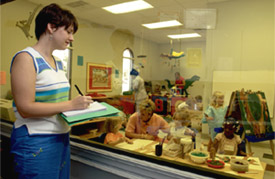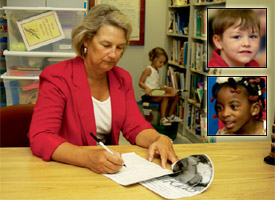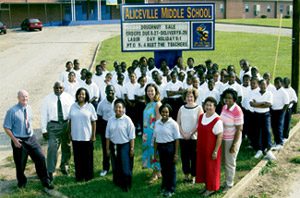
Pick a grim statistic—poverty, infant deaths, poor education, births to single mothers, unemployment, gaps in health care—and you’ll find the counties of Alabama’s Black Belt at the top of each category.
Nowhere in the state do children and families face more hardship than in Alabama’s Black Belt, where history, poverty and isolation have all contributed to low expectations and feelings of hopelessness.
And it is with these children and families that The University of Alabama is attempting to improve these statistics and give hope, especially in family-related areas such as child care/parenting, domestic violence, teen empowerment and health care availability.
Caring for the Children: Child Development Resources

Recent studies have shown that good preschool programs can help children in poverty, like those in the Black Belt, make a better start in their transition from home to community and thereby set more of them on the path to becoming economically self-sufficient, socially responsible adults.
Helping preschools with their efforts to reach these children is UA’s Child Development Resources (CDR). CDR addresses parenting and child care issues in a six-county region of west-central Alabama that includes three Black Belt counties: Bibb, Lamar and Pickens. Beginning in December 2003, six additional counties, Hale, Greene, Sumter, Perry, Marengo and Choctaw, will become part of the region served by CDR.

“Our primary focus is to improve the availability, affordability and quality of child care and to assist parents in the nurturing of their very young children,” said Sally Edwards, CDR director.
“Everything we do is designed to help improve the quality of child care for all children. We do that by helping parents become better consumers, and also through our training department, where we have child-development specialists who offer extensive training for child care providers,” she added.
Edwards said CDR offers financial assistance for parents, child care resource and referral, child care provider training, and parenting and educational support.
CDR offers child care subsidies that pay a portion of the child care costs for qualified parents who are either in school or have a job.
“So many of our clients are single mothers who need help with child care costs in order to work or to complete their educations as a means of becoming self sufficient. The whole point is for them to become more capable of supporting themselves and able to manage on their own and no longer in need of financial assistance,” she said.
During the past year CDR served over 2,700 children and 1,588 families, and had more than 2,300 participants in their child care training activities.
CDR battles the problem of parents’ lack of information through their child care resource and referral services, which provides parents with information about child care rules and regulations, how to recognize and choose a child care program, as well as educating them about their own child’s development.
“We’ve been able to blend resource and referral with our BabyTALK program so that parents are receiving good information not only about child care but also about their child’s development along with parenting resources.
“We give them information about child care regulations, how to recognize a quality child care program and what to look for when [they] go to visit a day care facility.
“So a large part of what we do is try to develop more informed consumers who can, by their own demands, help raise the quality of child care in Alabama,” Edwards explained.
Through CDR’s BabyTALK program parents receive child development and parenting information, suggestions for age-appropriate activities for their children and suggestions for encouraging nurturing relationships with their children.
Among the services offered by Baby TALK are mom/newborn hospital visits, “Warmline” phone service for parents, a weekly parent support group that blends parent-child activities with child development information, parent-child visits at local health clinics, and monthly family fun events for early Head Start children and their families.
Ensuring that these programs have quality child care workers is the other task of CDR. “Quality training activities are offered throughout the region and through multiple venues to improve the quality of child care programs and staff,” Edwards said.
Child development and administrative courses, as well as weekly workshops, are offered at the center on topics ranging from dealing with extreme behaviors in children using everyday resources as teaching materials, curriculum development, and classroom managements techniques to preventing health and safety problems.
The center houses a demonstration classroom and a resource lending library. The resource library is heavily used by the child care providers. They can check out teaching resources, children’s books, activity kits and use equipment such as die-cut machines to create interactive bulletin boards.
But, Edwards said they are finding themselves taking their resources out of the center and doing their training on-site at the child care facilities.
“Family child care providers make up the bulk of child care in the Black Belt, so they are isolated from the resources we have at the center. To be able to take resources out to them and to illustrate how these materials work in the providers’ own environment is really helpful to them,” she said.
“Doing on-site training helps the child care workers see the theories and activities put into practice with the children in their center. They really do learn how to integrate the knowledge with their practice, which is what we in child development always hope will happen,” Edwards said.
Keeping Children Healthy: The Alabama Child Caring Initiative

Like child care, access to health care and health insurance are areas where Black Belt counties usually land at the bottom, especially for its children.
But in one of those counties, Bibb County, the reverse has happened. Thanks to an initiative founded by UA, Bibb is one of the first, and perhaps only, counties in the United States to have achieved one hundred percent health insurance coverage for children.
This achievement was accomplished through the efforts of the Alabama Child Caring Initiative (CCI), a partnership founded by UA’s College of Community Health Sciences (CCHS) to increase health insurance coverage for children through community action.
Its mission is to ensure that all children from the involved communities are enrolled in a health insurance program, receive medical care and health information appropriate for their age, and develop expectations about personal health and hygiene that carry over to their families.
Bibb County was the first county to join the CCI. The Bibb County Child Caring Initiative (BCCCI) represents a collaborative effort between CCHS, the Bibb County community, the Rural Alabama Health Alliance, UA’s Capstone College of Nursing and Blue Cross Blue Shield of Alabama.
“BCCCI is founded on the idea that the strength of the local community must be engaged to successfully lead interested institutional partners in funding, implementing and evaluating a lasting and effective community endeavor,” said Dr. John Wheat, principal investigator of the first CCI project, and co-principal investigator of the Covering Kids and Families projects.
BCCCI collected data (later validated with school-based health examinations) concerning access, utilization and health behaviors/outcomes of children enrolled in the public school system.
“One of the more consistent themes of this data was that only children privately insured or children under age six and covered by Medicaid see a medical practitioner on a regular basis,” said Wheat, UA professor of community and rural medicine in CCHS.
Wheat pointed out that the disparity between insured and uninsured children is especially notable in terms of health utilization and health access.
“Uninsured children are far less likely to have a regular doctor. Uninsured children are also more likely to report having gone a longer time between health visits,” he said.
School-based health fairs, operated by UA faculty and students, along with community volunteers, assessed these children and provided needed health screening, education and referrals.
Wheat noted that UA’s Capstone College of Nursing was especially helpful with the fairs. “[UA nursing professor] Marsha Adams, a Bibb County resident, and UA’s nursing students played a key role in implementing these health fairs,” he said.
In the first year, over one-half of the children (57.5 percent) received a referral for follow-up care or evaluation. But the most notable outcome of the BCCCI has been the increase in insurance coverage among children. In 1996, 16 percent of children reported having no health coverage. In 2001, all children had coverage.
In response to Alabama’s new insurance program for low-income children, Covering Alabama’s Kids, the BCCCI took it upon themselves to assist and advocate for their children’s health insurance coverage.
Additionally, they served as a local resource for families completing applications and ensured that applications arrived in the hands of eligibility personnel complete and ready to be processed.
“It is the unique collaboration of CCI and the engagement of the community in finding solutions for ensuring child health coverage that has been the impetus for creating one hundred percent coverage among Bibb County children,” said Wheat.
“The community-led collaborations also give UA’s Rural Medical Scholars and nursing students the chance to work in rural Alabama,” he said.
“Several Black Belt counties are targets in the Covering Kids and Families Program, a Robert Wood Johnson Foundation-funded project, which builds on work done in BCCCI and extends the efforts of the Covering Alabama Kids project,” he added.
Initial success in Bibb County has led to program replication in Fayette, Pickens and Sumter counties, which are also member counties in the Rural Alabama Health Alliance.
“The primary lesson to be learned from Bibb County is that healthy communities take care of their kids and are capable [of doing so] given the opportunity to reach consensus, build collaborations and find solutions to insuring their children,” said Wheat.
Giving Them a Future: Future Selves

The Black Belt in Alabama has traditionally seen an exodus of community members and promising students who have left to pursue their careers elsewhere. This departure of citizens leaves a void of good role models and mentors who can help students plan for their futures and avoid the pitfalls of negative influences.
Teens account for nearly a third of all births in the Black Belt. There are also considerable problems with alcohol abuse, marijuana use and methylamphetamine drug use.
“Education is not valued by many students because they don’t see what it can do for them,” said Dr. Steve Nagy, UA professor of health education. “These students will ask why should I do well in school? What good will it do me?” he added.
Nagy is hoping to help change teens’ low expectations by using a program called Future Selves.
Now in its fifth year, Future Selves is a youth development program for students in grades 6 through 8, which encourages them to examine their life paths and focus on the future by setting goals, developing skills to achieve those goals and resisting peer pressure.
“UA’s goal, through this program, is to reach out to these young people, encourage thinking and decision-making skills, and showcase role models and behaviors that give them a positive future,” said Nagy.
Currently, 12 schools from three counties—Pickens, Bibb and Hale—are participating in the pilot phase.

Teens in both intervention and comparison groups were asked to complete a self-administered questionnaire, designed to assess the effectiveness of the curricula, both prior to the delivery of the program (pre-test) and following it (post-test).
Students in each of the three intervention groups (grades 6-8) were given 20 hours of curriculum instruction that included workbooks, videos, peer-led discussions, mentors, case studies and interactive group activities.
“Each grade level focuses on different aspects of a student’s life when addressing barriers that get in the way of having successful futures,” explained Nagy.
Grade 6’s theme is “Focus on Self: How Do We Become Who We Become?” Grade 7’s is “Legacy: What Do You Leave to Your Family and Friends as a Consequence of Your Existence?” Grade 8 presents “Success: What Does It Take to Achieve Personal Success?”
This school year, Future Selves will expand beyond the classroom and into the community. “We will be focusing our efforts on a stronger link between the communities and the school systems,” Nagy said.
Nagy said the project’s initial goal of creating strong materials and delivery methods has been achieved during this first phase. “I am very confident in our materials development and hope we can take them, apply for further funding, and move to the next level.”
While results are still being tabulated, Nagy said some evidence shows that they are making progress, although it is difficult to break a generations-long mind-set.
“It is very difficult to keep teens in rural areas encouraged because there’s not much there for them, and it is very hard to find a lot of positive role models,” he said.
Future Selves and CDR are both programs of UA’s College of Human Environmental Sciences.